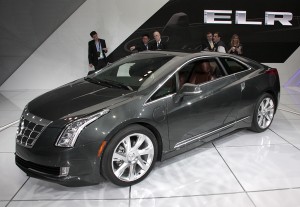With its new Cadillac ELR soon to come online, with new markets opening abroad and with its Chevrolet Volt now eligible for access to California’s coveted commuter lanes, General Motors hopes to substantially increase production of its plug-in hybrid-electric vehicles this year.
But after missing its ambitious sales goals for the first two years the Volt was on the market, it’s questionable whether market forces will support this year’s goal — especially with initial indications that the overall battery-electric market, which includes plug-in hybrids and pure battery-electric vehicles – stumbled again in February.
A report by the Bloomberg news service says GM is targeting a 20% increase in plug-in production for 2013, which would mean something on the order of 36,000 of the vehicles. “That’s close,” said one of several sources reached by TheDetroitBureau.com, especially “with the ELR coming” and other factors that could boost demand for the high-mileage technology.
But GM spokesman Kevin Kelly cautioned that the maker is taking a pull, rather than push, approach to battery-car production. “We’ll do whatever the market demands. We’re not going to force units onto the market.”
Introduced at the very end of 2010, the much-ballyhooed Chevrolet Volt has repeatedly fallen short of expectations, generating less than the anticipated 10,000 sales in 2011 and barely topping 22,000 last year – when initial plans targeted a figure closer to 45,000.
Volt did gain momentum during the final months of 2012, however, as an update for the 2013 model-year allowed it to qualify for a special sticker that lets it be driven in California’s HOV, or High-Occupancy Vehicle, lanes even with just one person aboard.
Further encouraging GM planners has been reception that both Volt and its fraternal twin, the Opel Ampera, have gotten in Europe, China and other overseas market.
There are other reasons why the maker is hopeful for the coming year, insiders explain. With gas prices again rising, that is expected to get American motorists focused once more on ways to hold down fuel bills. There has been an ongoing and direct correlation between sales of all battery-based vehicles, including conventional hybrids like the Toyota Prius, and surges in fuel costs.
(But one GM insider cautioned skepticism about the gas price link to demand, noting that preliminary industry data show that even with fuel costs spiking in February the entire electric vehicle segment experienced weaker than anticipated sales.)
GM’s so-called Voltec line could get a further boost later this year as Cadillac launches its new ELR, a high-line variation of the more mainstream Volt first revealed at the Detroit Auto Show in January.
The Caddy plug-in shares the Chevy model’s basic drivetrain and will deliver about the same, 38-mile range per charge – with its four-cylinder gas engine kicking in once the batteries are discharged. However, the ELR will get a modest boost in performance, according to chief engineer Chris Thomason, with 0 to 60 times expected to come in around 8.0 seconds, or a full second faster than the Chevrolet Volt.
The new model also will feature a more striking exterior design and a decidedly more lavish interior than its plebian cousin, though that is expected to add significantly to the $39,995 base price for Volt – before federal and state incentives.
As a result, the ELR was not seen as a way to add a huge amount of momentum to GM’s electrification program. “We’re not going to produce this vehicle in a lot of volume,” stressed chief engineer Thomason. “There will be something of an exclusive nature to owning this vehicle.”
GM officials are quick to admit some frustration with the reception Volt has so far received in the marketplace. The plug-in garnered extensive headlines when it debuted and it was named North American Car of the Year by a panel of 50 U.S. and Canadian journalists in January 2011. Meanwhile, research by Consumer Reports magazine has found 92% of owners would buy one again, the highest figure in the industry.
On the flip side, the vehicle, like General Motors itself, became entangled in politics during last year’s presidential campaign, the GOP contender Mitt Romney often criticizing Volt and the Obama Administration’s financial support for vehicle electrification.
Nonetheless, GM CEO Dan Akerson remains an unabashed cheerleader for the Volt and the maker’s other battery-based vehicles, even after admitting he had to slash his optimistic early plans for production in mid-2012.
When it first launched, Volt had relatively few competitors, primarily the fully electrified Nissan Leaf, but also the less expensive, more conventional Prius hybrid. This year, potential customers have a much wider range of alternatives, including two plug-ins from Ford, the Fusion and C-Max Energi models, a new plug-in based on the latest-generation Honda Accord and a variety of pure battery-electric models such as the Toyota RAV4-EV.
For the record, at least, GM officials including small car marketing chief Cristi Landy insist they welcome the added competition, something they believe will help increase awareness of the battery-car sector and convince skeptical shoppers that a vehicle like the Volt really is a viable alternative.

